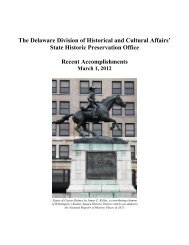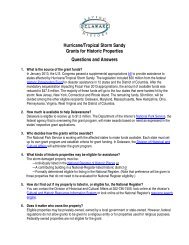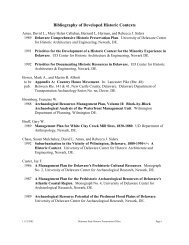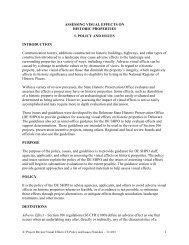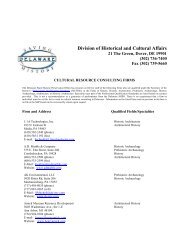Report of the Archaeological Investigations of the New Castle Court ...
Report of the Archaeological Investigations of the New Castle Court ...
Report of the Archaeological Investigations of the New Castle Court ...
Create successful ePaper yourself
Turn your PDF publications into a flip-book with our unique Google optimized e-Paper software.
NEW CASTLE COURT HOUSE PLAZA<br />
NEW CASTLE, DELAWARE<br />
3.0 FIELD RESULTS<br />
identified at subsoil interface. Thirteen <strong>of</strong> <strong>the</strong> 56 post holes, or approximately 23 percent, were<br />
sampled or fully excavated during <strong>the</strong> current fieldwork and only feature 31 contained a<br />
diagnostic artifact <strong>of</strong> yellow Staffordshire.<br />
Feature 8<br />
Feature 8 was originally identified during <strong>the</strong> 1995 fieldwork and <strong>the</strong> portion <strong>of</strong> this feature<br />
located within EU 4 was bisected during <strong>the</strong> current archeological work. The feature appeared at<br />
<strong>the</strong> top <strong>of</strong> <strong>the</strong> lower sand layer. Aggregate measurements <strong>of</strong> <strong>the</strong> feature are 1.2 by 0.9 ft., with a<br />
total <strong>of</strong> depth <strong>of</strong> 0.7 ft. A single pipe bowl fragment was recovered from <strong>the</strong> feature matrix.<br />
Feature 9<br />
Feature 9 was identified at <strong>the</strong> top <strong>of</strong> <strong>the</strong> lower sand layer within EU 1 and measures<br />
approximately 2 by 1.4 ft. and appears roughly rectangular in plan (Plate 17). The dissected<br />
feature extends 1.65ft. into <strong>the</strong> underlying subsoil, for an overall depth <strong>of</strong> approximately 1.95 ft.<br />
from <strong>the</strong> top <strong>of</strong> <strong>the</strong> base sand. Eighteen artifacts were recovered from this partially excavated<br />
feature, including one chalcedony flake, bone, oyster shell fragments, a hand painted underglaze<br />
porcelain sherd, sand tempered mortar, one pipe stem fragment, clear bottle glass, unidentified<br />
cut/wrought nails, and window glass. Brick fragments were discarded from <strong>the</strong> feature.<br />
Unfortunately, no diagnostic artifacts were recovered.<br />
Feature 10<br />
Feature 10 is a square cut post hole located along <strong>the</strong> eastern edge <strong>of</strong> EU 1. Identification <strong>of</strong> this<br />
post hole, which appears to have been cut by Feature 9, occurred at <strong>the</strong> top <strong>of</strong> <strong>the</strong> subsoil. The<br />
portion within EU 1 was excavated to a depth <strong>of</strong> 0.2 ft. into <strong>the</strong> surrounding subsoil. The west<br />
bisection yielded four artifacts including an oyster shell, two redware sherds, and one<br />
Staffordshire sherd. These artifacts were collected while brick fragments were discarded in <strong>the</strong><br />
field. Based on <strong>the</strong> recovery <strong>of</strong> <strong>the</strong> Staffordshire ceramic, <strong>the</strong> assemblage TPQ is 1670.<br />
Feature 14<br />
Feature 14 is a square cut post hole identified at <strong>the</strong> top <strong>of</strong> subsoil within EU 1. It measures 1 by<br />
0.7 ft. and continues 0.32 ft. into <strong>the</strong> substrata (Plate 17). A total <strong>of</strong> five artifacts were recovered<br />
including three olive green bottle fragment from <strong>the</strong> feature cleanup and two nail fragments from<br />
<strong>the</strong> east half bisection.<br />
Feature 15<br />
Feature 15 is a square cut post hole measuring 1 by 0.8 ft. and extending 0.2 ft. into <strong>the</strong> natural<br />
subsoil (Plate 17). This feature was identified in EU 1 at <strong>the</strong> top <strong>of</strong> <strong>the</strong> subsoil and appears to be<br />
cut by Features 14 and 16. No artifacts were recovered from <strong>the</strong> east bisection.<br />
Feature 16<br />
Feature 16 was identified in EU 1 at <strong>the</strong> interface with <strong>the</strong> subsoil. It is roughly rectangular in<br />
plan view and its measurements are 1.3 by 0.95 ft. (Plate 17). The eastern half was excavated and<br />
its depth extends 0.55 ft. into <strong>the</strong> surrounding subsoil. Two olive green bottle glass fragments<br />
were recovered from <strong>the</strong> excavated portion.<br />
Feature 26<br />
Feature 26 was identified at <strong>the</strong> subsoil interface in <strong>the</strong> nor<strong>the</strong>ast corner <strong>of</strong> EU 4. The portion<br />
within this unit, measuring 0.7 by 0.45 ft., was fully excavated to a depth <strong>of</strong> 0.5 ft. A total <strong>of</strong> three<br />
artifacts were recovered including a glass stemware base, one pipe stem fragment, and a nail.<br />
54



